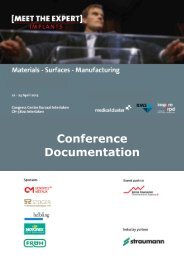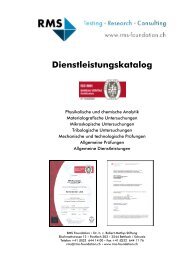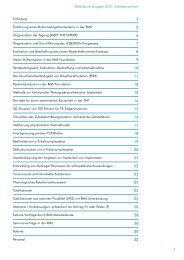RMS-Bericht 2012 - RMS Foundation
RMS-Bericht 2012 - RMS Foundation
RMS-Bericht 2012 - RMS Foundation
You also want an ePaper? Increase the reach of your titles
YUMPU automatically turns print PDFs into web optimized ePapers that Google loves.
<strong>RMS</strong> Report edition <strong>2012</strong> – Services<br />
Ringversuch «Biegeversuch an Metallen nach DIN EN ISO 7438»<br />
Interlaboratory test «Bend test of metals according to DIN EN ISO 7438»<br />
Das wohl wichtigste Instrument in der internen<br />
Qualitätskontrolle sowie der Kompetenzbewertung<br />
von Prüflaboratorien ist<br />
die Teilnahme an Ringversuchen. Solche<br />
Eignungsprüfungen werden vor dem Hintergrund<br />
der gegenseitigen internationalen<br />
Anerkennung immer wichtiger. Auch im Rahmen<br />
der Begutachtung von Prüflaboratorien<br />
zur Akkreditierung nach ISO/IEC 17025 werden<br />
Ringversuche als Mittel zur Sicherung der<br />
Qualität von Prüf- und Kalibrierergebnissen<br />
sowie der Messunsicherheit angesehen.<br />
Die <strong>RMS</strong> nimmt jährlich an diversen Ringversuchen<br />
teil. Ein Beispiel dafür ist der «Biegeversuch<br />
an Metallen nach DIN EN ISO<br />
7438», welcher 2011 erstmals vom Institut<br />
für Eignungsprüfung (Marl / D) organisiert<br />
wurde. Insgesamt nahmen 21 Prüflaboratorien<br />
aus 13 Nationen an dieser Bestandesaufnahme<br />
teil. Eine repräsentative Beurteilung<br />
der internationalen Umsetzung dieses<br />
Normversuchs war damit gewährleistet. In<br />
der Durchführung mussten mittig verschweisste<br />
Proben auf einer Universalprüfmaschine<br />
(die <strong>RMS</strong> verwendete eine Zwick 1474 / 100<br />
kN) bei Raumtemperatur bis zu einem Biegewinkel<br />
von α = 120° gebogen werden. Dabei<br />
wurden folgende Kenngrössen ermittelt:<br />
Biegewinkel α, Vorschubweg f und das Vorhandensein<br />
von Rissen, beurteilt ohne Einsatz<br />
von Vergrösserungsmitteln.<br />
Insgesamt wies das Ergebnis der Eignungsprüfung<br />
eine sehr gute Qualität der Durchführung<br />
dieses Biegeversuchs auf. Die Normanforderungen<br />
wurden richtig interpretiert<br />
und umgesetzt. Das erwartete Rissverhalten<br />
der eingesetzten Proben wurde in vielen Labors<br />
gefunden. Die Ergebnisse bestätigen,<br />
dass die Ausbildung der Prüfer, der Zustand<br />
und die Kalibrierung der eingesetzten Prüfgeräte<br />
ein hohes Niveau erreicht haben. Sehr<br />
erfreulich ist, dass die von der <strong>RMS</strong> <strong>Foundation</strong><br />
erarbeiteten Ergebnisse ebenfalls als<br />
sehr gut beurteilt wurden.<br />
Probably the most important instrument in the<br />
internal quality control and the expertise validation<br />
of test laboratories is the participation<br />
in interlaboratory tests. These qualification<br />
tests are becoming more and more important<br />
against the background of the mutual international<br />
acceptance. Also in the assessment<br />
of test laboratories for the accreditation according<br />
to ISO/IEC 17025, the interlaboratory<br />
tests are considered a means to ensure<br />
the quality of test and calibration results as<br />
well as of measuring uncertainty.<br />
The <strong>RMS</strong> participates every year on different<br />
interlaboratory tests. An example is the<br />
«bend test of metals according to DIN EN ISO<br />
7438», which the Institut für Eignungsprüfung<br />
(Marl/D) organised for the first time in 2011.<br />
A total of twenty-one test laboratories from<br />
thirteen nations participated in this appraisal.<br />
This ensured a representative evaluation of<br />
the international realisation of the standard<br />
test. The implementation included bending<br />
the specimens<br />
welded in the<br />
middle up to a<br />
bending angle<br />
of α = 120° at<br />
room tempera<br />
ture on a univer<br />
sal testing<br />
machine (the<br />
<strong>RMS</strong> used a<br />
Zwick 1474 /<br />
100 kN). The<br />
following characteristics<br />
were<br />
established in<br />
the process:<br />
ben ding angle α, feed rate f and the existence<br />
of cracks, assessed without the use of<br />
magnifying aids.<br />
The result of these bending tests showed a<br />
very good quality of the performance. The<br />
standard requirements were interpreted and<br />
implemented correctly. The expected crack<br />
behaviour of the specimens used was found<br />
in many laboratories. The results confirm that<br />
the formation of the investigators, the state<br />
and the calibration of the testing devices used<br />
have reached a high level.<br />
It was very gratifying that the results worked<br />
out by the <strong>RMS</strong> <strong>Foundation</strong> were considered<br />
excellent as well.<br />
Ph. Däster<br />
F. Bigolin<br />
L. Radicic<br />
Abbildungen:<br />
Links: Kraft-Weg-Diagramm<br />
einer Biegeprobe mit den<br />
Angaben Fmax und Weg bis<br />
Biegewinkel α = 120°.<br />
Rechts: Versuchsaufbau mit<br />
einer gebogenen Probe bei<br />
Biegewinkel α = 120°.<br />
Figures:<br />
Left: Force-displacement<br />
chart of a bending specimen<br />
with the details Fmax and<br />
displacement up to a bending<br />
angle of α = 120°.<br />
Right: Test setup with a<br />
curved specimen at a<br />
bending angle α = 120°.<br />
7





